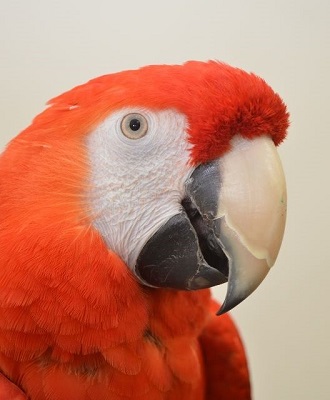
Our Animal of the Month for October didn’t want to interfere with Halloween, so the scarlet macaw is flying out of the spotlight a day early. We hope you enjoyed following us @ExoticPetVets on Twitter as we tweeted about these big and beautiful birds. But in case you missed any of our tweets, we are offering a summary for your reference. Did you know?:
- Scarlet macaws (Ara macao) in the wild have a huge range that extends from southeastern Mexico in the north to central Bolivia in the south and many points in between, including Brazil, Peru, Guatemala and Panama.
- Given their geographical range, it’s not surprising that wild scarlet macaws call the dense rainforests in the region home. They live in the tall trees of the rainforest canopy, with nearby rivers providing their water source.
- Scarlet macaws are large parrots, with adults measuring 32 to 39 inches (almost one metre on average) in length – and much of that is their tail!
- As their name suggests, scarlet macaws are mostly red, but they have blue feathers on their lower back, their wings and part of their tail. They also have yellow feathers tipped with green on their wings.
- Scarlet macaws have pale or white faces with yellow eyes. They have large beaks – the upper beak is an ivory colour while the lower beak is dark grey or black.
- ‘Til death do they part. Did you know that scarlet macaws are monogamous and mate for life?
- Scarlet macaws reach sexual maturity around 3 to 4 years of age and they are slow-breeding birds.
- A scarlet macaw pair in the wild will build a nest in a hole of a dead canopy tree. The female will lay a clutch of between 2 and 4 eggs and will do most of the incubating. It takes about 25 days for the eggs to hatch.
- Male scarlet macaws are very involved fathers and will take care of all of the feeding of their babies.
- Baby scarlet macaws usually stay with their parents for 1 to 2 years, during which time the parents will not breed again. They will wait to create more offspring until their babies become juveniles and leave the nest.
- Scarlet macaws are very social birds and are rarely seen alone in the wild. They typically flock together in groups of about 10 to 30 birds.
- Scarlet macaws are also diurnal birds, who are active during daylight hours. They will gather with their flock to sleep together as a group at night and will fly long distances to forage for food during the day.
- Scarlet macaws are omnivores, meaning they eat both plant and animal matter. In the wild, most of their diet consists of nuts, seeds and fruit. They also eat insects and snails.
- A tough nut to crack is not a problem for the strong curved beaks of scarlet macaws, who can easily break through hard shells. Scarlet macaws also have slightly scaly and dry tongues that have a bone inside, which helps them break open and eat their food.
- While it sounds rather unappetizing, wild scarlet macaws will eat certain types of clay in a practice known as geophagia.
- Wild scarlet macaws will eat some seeds and unripe fruits that are actually toxic. But when they eat clay, the clay will neutralize the toxins so the scarlet macaws won’t be harmed.
- The scarlet macaw is the national bird of Honduras. But despite this honour, they are rarely seen in the wild there. The scarlet macaw population in Honduras is being decimated by rampant poaching and habitat destruction.
- American ex-pat Lloyd Davidson (a.k.a. The Bird Man of Roatan) owns the Macaw Mountain Bird Park in Honduras and is working with World Parrot Trust on a captive breeding program to increase the wild scarlet macaw population.
- Scarlet macaws have something in common with humans – a long life span. In the wild, scarlet macaws usually live between 40 and 50 years. With proper care, they can live between 70 and 90 years in captivity.

